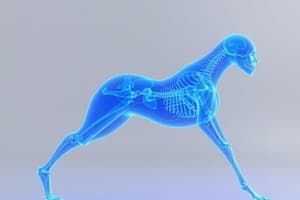Podcast
Questions and Answers
What is the primary characteristic of motor learning?
What is the primary characteristic of motor learning?
- Relatively permanent changes in movement capability (correct)
- Rapid improvement in performance during practice
- Consistency in performance during practice and competition
- Immediate application of skills in different contexts
Which of the following best describes adaptability in motor skills?
Which of the following best describes adaptability in motor skills?
- Demonstrating stable performance despite disturbances
- Executing the skill at a higher level than before
- Transferring knowledge to new situations or environments (correct)
- Performing consistently across different trials
What does a retention test assess?
What does a retention test assess?
- How well a skill can be transferred to a new context
- The speed of learning during the acquisition phase
- Long-term retention of a motor skill after a period without practice (correct)
- The performance level immediately after practice
Which term describes the information sourced from the external environment?
Which term describes the information sourced from the external environment?
What is the significance of latent learning in skill acquisition?
What is the significance of latent learning in skill acquisition?
What describes the concept of the Response-chaining hypothesis?
What describes the concept of the Response-chaining hypothesis?
Which system executes instructions without the ability to detect or correct errors?
Which system executes instructions without the ability to detect or correct errors?
What does the Law of Practice state about performance improvements?
What does the Law of Practice state about performance improvements?
Which type of feedback is provided during the performance of a task?
Which type of feedback is provided during the performance of a task?
What is the primary function of the Forgetting-Reconstruction hypothesis?
What is the primary function of the Forgetting-Reconstruction hypothesis?
Which tactile sensory receptor is classified as superficial and fast-adapting, primarily responsible for stroking and fluttering sensations?
Which tactile sensory receptor is classified as superficial and fast-adapting, primarily responsible for stroking and fluttering sensations?
What role does the M-pathway play in visual perception?
What role does the M-pathway play in visual perception?
Which statement best describes the dorsal system in visual processing?
Which statement best describes the dorsal system in visual processing?
Which proprioceptive receptors are sensitive to tension in muscles?
Which proprioceptive receptors are sensitive to tension in muscles?
In a closed-loop control system, what is the purpose of the comparator?
In a closed-loop control system, what is the purpose of the comparator?
Which tactile sensory receptor is responsible for encoding pressure and texture, while being classified as superficial and slow-adapting?
Which tactile sensory receptor is responsible for encoding pressure and texture, while being classified as superficial and slow-adapting?
What is the primary role of the Golgi Tendon Organs within proprioceptive receptors?
What is the primary role of the Golgi Tendon Organs within proprioceptive receptors?
Which visual processing pathway is primarily responsible for recognizing objects and operates using cones?
Which visual processing pathway is primarily responsible for recognizing objects and operates using cones?
In a closed-loop control system, which aspect ensures that the desired state increments towards the expected state?
In a closed-loop control system, which aspect ensures that the desired state increments towards the expected state?
What describes the phenomenon where sensory information is combined from various sources to create a comprehensive perception of the environment?
What describes the phenomenon where sensory information is combined from various sources to create a comprehensive perception of the environment?
What is a defining characteristic of a quick learner in skill acquisition?
What is a defining characteristic of a quick learner in skill acquisition?
Which term describes the ability to perform a skill successfully in altered conditions?
Which term describes the ability to perform a skill successfully in altered conditions?
Which type of feedback is described as information that is directly available through one's senses?
Which type of feedback is described as information that is directly available through one's senses?
What does a transfer test aim to assess in the context of learning a skill?
What does a transfer test aim to assess in the context of learning a skill?
What characteristic distinguishes latent learning from observable performance improvements?
What characteristic distinguishes latent learning from observable performance improvements?
Flashcards
Motor skill stability
Motor skill stability
The ability to perform a motor skill consistently, accurately, and efficiently, even in different contexts and environments.
Motor skill adaptability
Motor skill adaptability
The ability to perform a motor skill successfully in new situations or contexts.
Exteroceptive feedback
Exteroceptive feedback
Information about the state of the environment in which the body exists, such as visual, auditory, or tactile information.
Proprioceptive feedback
Proprioceptive feedback
Signup and view all the flashcards
Intrinsic feedback
Intrinsic feedback
Signup and view all the flashcards
Merkel cell
Merkel cell
Signup and view all the flashcards
Meissner corpuscle
Meissner corpuscle
Signup and view all the flashcards
P-pathway
P-pathway
Signup and view all the flashcards
Muscle spindle
Muscle spindle
Signup and view all the flashcards
Closed-loop control system
Closed-loop control system
Signup and view all the flashcards
Reaction Time
Reaction Time
Signup and view all the flashcards
Open-Loop Control System
Open-Loop Control System
Signup and view all the flashcards
Response-Chaining Hypothesis
Response-Chaining Hypothesis
Signup and view all the flashcards
Drum Theory
Drum Theory
Signup and view all the flashcards
Law of Practice
Law of Practice
Signup and view all the flashcards
Motor learning
Motor learning
Signup and view all the flashcards
Proprioceptive Receptor
Proprioceptive Receptor
Signup and view all the flashcards
Golgi Tendon Organ
Golgi Tendon Organ
Signup and view all the flashcards
Optical Flow
Optical Flow
Signup and view all the flashcards
Sensory Integration
Sensory Integration
Signup and view all the flashcards
Study Notes
Defining and Assessing Learning
- Motor learning: Internal processes associated with practice, leading to relatively permanent changes in movement capability.
- Performance: Executing a skill at a specific time and in a specific situation.
- Improvement: Skill level is higher than in previous attempts.
- Consistency: Performance characteristics become more similar from one attempt to another.
- Stability: Performing the same skill in different contexts/environments, handling influences on performance.
- Adaptability: Skillfully performing a skill in changed circumstances, transferring knowledge to other situations.
- Persistence: Improved skill capability lasts a long time.
- Quick learner: Rapid improvement in performance.
- Normal learner: Slower improvement, eventually higher performance.
- Latent learning: Performance doesn't change, but learning still occurs.
- Retention test: Assessment of learning after a period of no practice.
- Transfer test: Assessing learning's generalization to different contexts.
- Retention test with a retention interval: Test after sufficient time between practice and assessment.
Sensory Contributions
- Exteroceptive: Information from outside the body (environment).
- Proprioceptive: Information from within the body (body parts' state relative to each other and the environment).
- Intrinsic feedback: Naturally available sensory information.
- Augmented feedback: Information not normally available.
- Tactile receptors: Merkel cells (slow-adapting), Meissner's corpuscles (fast-adapting), Pacinian corpuscles (fast-adapting), Ruffini corpuscles (slow-adapting).
- Visual receptors: M-pathway (visual control of action); P-pathway (object recognition).
- Optical Array: Information from light rays entering the eyes at specific angles.
- Optical flow: Changes in optical array information, providing movement information about a surrounding environment.
- Vestibular/audition receptors: Information about movements or orientation.
- Proprioceptive Receptors: Muscle spindles (rate of change in muscle length), Golgi tendon organs (tension), Joint receptors (Sensory information about joint position).
Motor Programs
- Generalized Motor Program (GMP): Set of parameters (e.g., force, angle) specified before a trial.
- Rapid movements: Organized and fast sequences of muscle movements.
- Response-chaining hypothesis: First muscle contraction requires more attention than subsequent contractions in a chain of movements.
- Drum theory: Sensory experience leaves an imprint.
- Reaction time: Time between a signal and completing an action.
- Open-Loop control system: Execution without modification and no feedback (e.g. traffic signals).
- Closed-Loop control system: Feedback loop continues until desired state is met (e.g. holding cup).
- Novelty problem: Difficulty creating new motor plans.
- Storage problem: Concern about how many motor plans the memory can hold.
- Invariant features: GMP characteristics remaining the same.
- Parameters: Characteristics of GMP that change and affect execution.
- Surface Features: Changes allowed by GMP parameters.
- Deep Features: GMP characteristics not subject to change.
- Motor Program: a set rule or plan of movements, before a skill trial.
Conditions of Practice
- Law of practice: Initial improvement is steep, followed by gradual lessening.
- Power Law of practice: Improvement is related to practice hours logged.
- Deliberate Practice: Activities designed to improve performance, effortful.
- Off-task practice: Learning when not actively engaged in the skill.
- On-task Practice: Learning when actively engaged in the skill.
- Part Practice: Separate drills for each part of a skill.
- Guidance: Assistance provided during skill execution.
- Variability of practice: Training in different contexts, and with variations.
- Contextual Interference: Multiple tasks influence each other; practice with multiple skills.
- Elaborative/Distinctive hypothesis: Comparing and contrasting tasks when learning.
- Forgetting-Reconstruction Hypothesis: Learning task A and then Task B requires "forgetting" task A
- Working memory: Short-term storage.
- Blocked Practice: Completing all trials of one task before moving on.
- Random Practice: Mixing practice order of tasks.
- Perceptual Learning: Skill improvement from demonstrations or observation.
Augmented Feedback
- Augmented Feedback: Additional information about the action, supporting natural feedback.
- Concurrent feedback: Provided during performance.
- Terminal feedback: Provided after performance.
- Immediate feedback: Provided immediately after performance.
- Verbal feedback: Spoken.
- Delayed feedback: Provided after a delay.
- Knowledge of Result (KR): Information about the outcome of the movement.
- Knowledge of Performance (KP): Information about the execution of the movement.
- Bandwidth KR: Errors tolerance levels for feedback.
- Temporal locus of KR: Timing of KR.
- Video feedback: Visual review of movement.
- Kinematic feedback: Measurement of movement (position, time, velocity).
- Biofeedback: Feedback about bodily functions.
- Kinetic feedback: Descriptors of forces.
Mental Practice
- Mental practice: Cognitive rehearsal without physical movement.
- Imagery: Visual and kinesthetic mental representations of actions.
- Aphantasia: Inability to form mental images.
- Motivational imagery: Mental images for goals and motivation.
- Cognitive imagery: Represents different skills and strategies.
- Neuromuscular hypothesis: Mental imagery influences neuromuscular activity similarly to physical movement.
- Cognitive hypothesis: Cognitive aspects of a task are mentally rehearsed before its physical execution.
- Internal Imagery: Individual experiences the sensation of executing the movement physically.
- External Imagery: Individual views themselves performing the movement from an outside perspective.
- Kinesthetic Imagery: Feeling the movement being performed.
Amount & Distribution of Practice
- Overlearning: Continuing practice beyond achieving the goal.
- Procedural Skills: Skills well suited for overlearning.
- Distribution of Practice: Amount of rest between practice trials.
- Massed practice: Short rest intervals.
- Distributed practice: Long rest intervals.
- Memory Consolidation: Process of long-term memory storage.
- Continuous skills: Skills involving a continuous sequence of movements.
- Discrete skills: Skills with distinct beginning and end points.
- Overlearning: Continuing practice beyond achieving the goal.
Studying That Suits You
Use AI to generate personalized quizzes and flashcards to suit your learning preferences.




